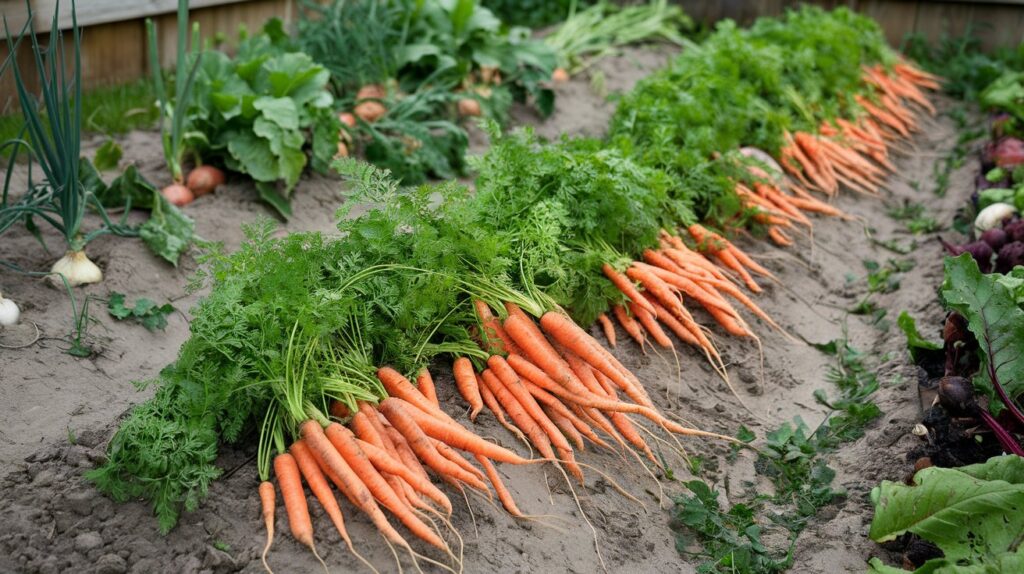Interested in learning how to grow carrots in your home garden but don’t know where to start? Carrots are a great addition to any garden, even if you’re a beginner. Growing carrots at home is surprisingly easy, and they’re packed with vitamins, minerals, and fiber that make them an excellent part of a healthy diet. This guide covers everything you need to know about planting carrot seeds, nurturing their sprouts, and harvesting them for fresh, crunchy carrots.
Whether you have a small backyard, balcony, or even a container, these simple steps will help you cultivate delicious carrots right at home.
1. Choose the Right Carrot Variety for Your Home Garden
Carrots come in many shapes, sizes, and colors, and certain types grow better in smaller spaces. Here are some popular varieties:
- Nantes: These carrots are known for their sweet taste and grow well in containers.
- Chantenay: These short, stocky carrots are ideal for shallow or rocky soil, making them great for raised beds.
- Miniature Carrots: Perfect for small containers, these carrots mature quickly and fit well in compact spaces.
Choosing the right variety based on your garden size will make the process easier and more rewarding.
2. Prepare Your Soil for Healthy Carrot Growth
Carrots need loose, well-draining soil for their roots to grow without obstruction. Here’s how to prepare the soil in your garden or container:
- Clear Rocks and Debris: Remove any stones, sticks, or hard clumps in the soil. These can obstruct root growth and lead to misshapen carrots.
- Loosen the Soil: Use a garden fork or shovel to dig about 12 inches deep and break up the soil.
- Add Compost: Carrots thrive in nutrient-rich soil, so mix in organic compost for better growth and flavor. Avoid using fresh manure, as this can lead to misshapen carrots.
- Check Soil pH: Carrots grow best in a slightly acidic to neutral pH (6.0-7.0). Adjust accordingly if your soil is too acidic or alkaline.
3. Planting Carrot Seeds: Timing and Spacing
Carrots are cool-season vegetables, so early spring or late summer is ideal for planting them. They grow best when temperatures range from 60-70°F.
- Sow Seeds Shallowly: Carrot seeds are tiny, so plant them about ¼ inch deep. Gently cover with a thin layer of soil.
- Spacing: Space seeds about 2 inches apart to allow for proper root development. If you’re planting in rows, keep rows about 12 inches apart.
- Maintain consistent moisture for carrot seeds to support germination. Use a gentle spray to avoid disturbing the seeds, and keep the soil damp but not waterlogged.
4. Watch for Carrot Sprouts and Thin Seedlings
Keywords: carrot sprouts, thinning seedlings, germination
Carrot seeds can take anywhere from 10 to 21 days to sprout, so be patient. Once they start sprouting:
- Thin Out Seedlings: Carrot seedlings can be quite dense. Once they’re about 2 inches tall, thin them out to leave about 2-3 inches of space between each plant. This spacing helps each carrot develop fully without overcrowding.
- Mulch Lightly: Add a thin layer of mulch around the sprouts to retain moisture and keep weeds at bay. Be cautious not to cover the sprouts themselves.
5. Watering and Caring for Your Carrot Plants
Carrots need consistent moisture but don’t like waterlogged soil. Here’s how to care for your carrots as they grow:
- Water Deeply: Carrot roots grow deep, so water deeply to encourage root growth. Provide about 1 inch of water per week, adjusting as needed for rainfall.
- Avoid Overwatering: Overly wet soil can lead to rot or deformed carrots. Check the soil before watering and adjust if it feels damp.
- Watch for Pests: While carrots are relatively pest-resistant, they can attract carrot rust flies and aphids. Use natural insecticidal soap or cover with a light row cover to protect your plants.
6. Harvesting Carrots: When and How to Pull Them Up

Knowing when to harvest carrots depends on the variety you planted, but generally, carrots are ready for harvest 60-80 days after planting.
- Check the Size: Gently brush away some soil at the base of the greens to check the carrot’s diameter. Most are ready to pick when they reach about ¾ inch in diameter.
- Pull Gently: Grasp the greens near the base and pull firmly. If the soil is hard, use a small garden fork to loosen it before pulling.
- Harvest Continuously: For fresh carrots all season, plant seeds every 2-3 weeks and harvest them in succession.
7. Carrot Health Benefits: Why Growing Carrots at Home Is Worth It
Not only are homegrown carrots delicious, but they’re also packed with nutrients. Carrots are an excellent source of:
- Vitamin A: Promotes good vision, immune health, and skin vitality.
- Fiber: aids digestion and contributes to maintaining a healthy weight.
- Antioxidants: Carrots contain beta-carotene, a powerful antioxidant that can protect your body from free radical damage.
Growing your own carrots ensures they’re as fresh and nutritious as possible, allowing you to enjoy the full benefits of this root vegetable.
8. Growing Carrots in Containers: Tips for Small Spaces
If you don’t have a garden, you can still grow carrots in containers. Here’s how:
- Choose a Deep Container: Carrot roots need depth, so pick a container that’s at least 12 inches deep.
- Use Well-Draining Potting Mix: Regular garden soil can become compact in containers, so use a light, well-draining mix.
- Water Regularly: Container soil dries out faster, so check moisture levels more frequently. Carrots in containers may need watering every 2-3 days.
Conclusion
Growing carrots in your home garden is simple and rewarding. With a bit of preparation and patience, you can enjoy fresh, nutritious carrots straight from your own backyard. Whether you plant them in the ground or a container, the steps are straightforward for beginners. Try it out, and you’ll discover just how tasty and rewarding homegrown carrots can be!




